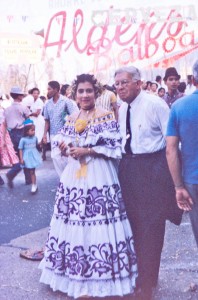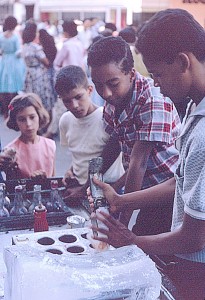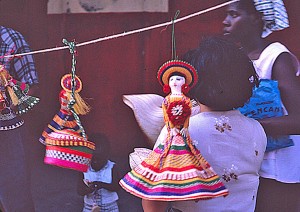Posts Tagged ‘Music’
Encountering Carnival in Panama
Panama City, March 1962
I had no idea that we’d arrive in Panama during Carnival. Even as our ship sidled into port at the end of the Pacific crossing, we could hear the sounds of it, the ramshackle city pulsing to a beat like none I’d ever heard. Once docked and allowed to disembark, we passengers pushed our way through dense crowds of people, among which wove decorated floats, costumed dancers, bands crowded onto the beds of battered trucks, men on the street beating drums or, lacking drums, the metal sides of the trucks, all singing and shouting to the heady Latin American rhythms. Sometimes a figure in fantastic costume would pass, surrounded by a group of friends singing and shouting together.
Everyone dresses up for Carnival. I was fascinated to see women wearing the pollera, the Panamanian national costume. Spanish in origin and atmosphere, the dress is of white cambric, embroidered in a bold floral pattern in a contrasting color, usually red, black or blue, each frill trimmed with a border of hand-made lace.
At roadside stalls we watched Panamanian boys scrape blocks of ice for the local sweet. They pressed the ice shavings into a paper cup, and poured over it a bright colored syrup and condensed milk. A bit tasteless, but very refreshing.
Passengers had been warned before we disembarked about the level of crime on Panama’s streets. There’s a hint of bravado in my letter to parents: “You just didn’t go into the side streets, or you would be unlikely to come back alive. Pickpockets everywhere. We were either lucky or careful (or both) but many of the passengers had purses, wallets or cameras stolen.”
What I didn’t write about was the effect on me of the incessant drums, the shouts and snatches of tune, the rhythm syncopated, hypnotic. I wanted to drown in it, swirl with the dancers forever into the glittering ocean of color and sound. But like the hawsers holding the ship to the dock, my past tethered me: syrupy fifties songs about marriage and children, strictures on proper behavior, appropriate dress. We wandered in the crowd for a day, then moved on.
All photographs are by Tony Eppstein.
Maureen is exploring the contents of an old black filing cabinet in her attic, which contains 55 years of her writing notes and memorabilia.
Words and Music from an Inner Garden
For more than forty years, my friend Diana Neutze has endured the relentless thefts of multiple sclerosis and grief for a son lost too young. Throughout that time, she has continued to write powerful and moving poems. Recently, her body closing down, she commissioned the New Zealand composer Anthony Ritchie to set some of her poems to music. The cycle of seven songs, “Thoughts from an Inner Garden” premiered April 2011 in a performance at Diana’s house in Christchurch, New Zealand. Diana recently sent me a CD of that performance. I’ve been playing it over and over, overwhelmed by the beauty and intensity of the work.
From Diana Neutze’s published collections, A ROUTINE DAY and UNWINDING THE LABYRINTH, Ritchie selected poems that express the poignancy of the poet’s sense of connection with the tangled garden that surrounds her house, a garden that has become her world. Transcending the nightmare of her chronic illness, she finds meaning in the details of the natural world: the play of light and shadow, the song of a bird.
The cycle opens in a minor key, an ancient, timeless sound that describes a day of wet greyness without wind when the garden is holding its breath. In “Bridal,” the second song, the poet, showered by autumn gold, imagines the roses and smoke bush as witnesses to a marriage between herself and the garden. The mood changes in “Chronic,” where Ritchie’s urgent rhythm reflects the tick-tocking of illness/ relentlessly. “And the Birds Sing” is a meditation on the cycles of life and death. “A Scent of Water” offers a fragile hope in the face of grief: a frosting of growth/ a shivering of buds in the morning light. The rhythms of an old folk dance come to mind in “Meaning.” A moment in late afternoon, a blackbird singing in a weeping elm, and the day is flooded with meaning. The cycle closes with “Goodbye.” The poet recalls the garden images she will die loving. The theme of a Bach partita enters the music as she describes its architectural splendour … arch after musical arch soaring upwards.



